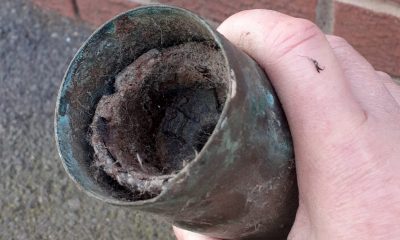This is the world’s smallest man-made flying machine
Scientists say the 'microfliers' could monitor air pollution, airborne disease, and environmental contamination.
Published
2 years ago onBy Stephen Beech via SWNS
A winged microchip about the size of a grain of sand has become the world's smallest man-made flying machine.
Scientists say the 'microfliers' could monitor air pollution, airborne disease, and environmental contamination.
The tiny device does not have a motor or engine. Instead, it catches flight on the wind - just like a maple tree’s propeller seed - and spins like a helicopter through the air toward the ground.
By studying maple trees and other types of wind-dispersed seeds, engineers optimized the microflier’s aerodynamics to ensure that when dropped from high up, it falls at a slow velocity in a controlled manner.
Engineers explained in the journal Nature how that stabilizes its flight, ensuring dispersal over a broad area.
It also increases the amount of time it interacts with the air, making it ideal for monitoring air pollution and airborne disease.

Bioelectronics pioneer Professor John Rogers, who led the development, said: “Our goal was to add winged flight to small-scale electronic systems.
“We were able to do that using ideas inspired by the biological world.
"Over the course of billions of years, nature has designed seeds with very sophisticated aerodynamics.
"We borrowed those design concepts, adapted them, and applied them to electronic circuit platforms.
“Evolution was likely the driving force for the sophisticated aerodynamic properties exhibited by many classes of seeds.
"These biological structures are designed to fall slowly and in a controlled manner, so they can interact with wind patterns for the longest possible period of time.
"This feature maximizes lateral distribution via purely passive, airborne mechanisms.”

To design the microfliers, Rogers and his colleagues at Northwestern University in Illinois drew direct inspiration from the tristellateia, a flowering vine with star-shaped seeds.
Tristellateia seeds have bladed wings that catch the wind to fall with a slow, rotating spin.
The team designed and built many different types of microfliers, including one with three wings, optimized to similar shapes and angles as the wings on a tristellateia seed.
To pinpoint the most ideal structure, Professor Yonggang Huang, who led the study’s theoretical work, conducted full-scale computational modeling of how the air flows around the device to mimic the tristellateia seed’s slow, controlled rotation.
Based on this, Rogers’ group then built and tested structures in the lab, using advanced methods for imaging and quantifying patterns of flow.
The resulting structures can be formed across a wide variety of sizes and shapes, some with properties that Rogers says can give nature "a run for its money."
Rogers said: “We think that we beat nature."
“At least in the narrow sense that we have been able to build structures that fall with more stable trajectories and at slower terminal velocities than equivalent seeds that you would see from plants or trees.
"We also were able to build these helicopter flying structures at sizes much smaller than those found in nature.
"That’s important because device miniaturization represents the dominating development trajectory in the electronics industry, where sensors, radios, batteries, and other components can be constructed in ever-smaller dimensions.”
To manufacture the devices, Rogers’ team drew inspiration from a child’s pop-up book.
His team first fabricated precursors to flying structures in flat, planar geometries. Then, they bonded the precursors onto a slightly stretched rubber substrate.
When the stretched substrate is relaxed, a controlled buckling process occurs that causes the wings to “pop up” into precisely defined three-dimensional forms.
Rogers said: “This strategy of building 3D structures from 2D precursors is powerful because all existing semiconductor devices are built in planar layouts.
“We can thus exploit the most advanced materials and manufacturing methods used by the consumer electronics industry to make completely standard, flat, chip-like designs.
"Then, we just transform them into 3D flying shapes by principles that are similar to those of a pop-up book.”
He explained that the microfliers comprise two parts: millimeter-sized electronic functional components and their wings. As the microflier falls through the air, its wings interact with the air to create a slow, stable rotational motion.

The weight of the electronics is distributed low in the center of the microflier to prevent it from losing control and chaotically tumbling to the ground.
Rogers’ team included sensors, a power source that can harvest ambient energy, memory storage, and an antenna that can wirelessly transfer data to a smartphone, tablet, or computer.
The team outfitted one device with all of the elements to detect particulates in the air. In another example, they incorporated acidity sensors that could be used to monitor water quality and photodetectors to measure sun exposure at different wavelengths.
Rogers says that large numbers of devices could be dropped from an aircraft or building and broadly dispersed to monitor the air after a chemical spill or to track levels of air pollution at various altitudes.
He said: “Most monitoring technologies involve bulk instrumentation designed to collect data locally at a small number of locations across a spatial area of interest.
“We envision a large multiplicity of miniaturized sensors that can be distributed at a high spatial density over large areas, to form a wireless network.”
Rogers even has a plan to deal with any electronic litter. His team already develops transient electronics that can harmlessly dissolve in water after they are no longer needed - as shown in recent work on bioresorbable pacemakers.
Now his team is using the same materials and techniques to build microfliers that naturally degrade and disappear in groundwater over time.
Prof Rogers added: “We fabricate such physically transient electronics systems using degradable polymers, compostable conductors, and dissolvable integrated circuit chips that naturally vanish into environmentally benign end products when exposed to water.
“We recognize that recovery of large collections of microfliers might be difficult. To address this concern, these environmentally resorbable versions dissolve naturally and harmlessly.”
Stories and infographics by ‘Talker Research’ are available to download & ready to use. Stories and videos by ‘Talker News’ are managed by SWNS. To license content for editorial or commercial use and to see the full scope of SWNS content, please email [email protected] or submit an inquiry via our contact form.
You may like


New breakthrough treatment boosts cancer-fighting cells


Signs of multiple sclerosis can show up in blood years before symptoms


Why baby sharks prefer swimming in shallow water


Scientist transforms climate change data into classical music


Breakthrough may help unlock way to prevent diabetes


Having this type of job could reduce risk of memory issues
Other Stories


New breakthrough treatment boosts cancer-fighting cells
The approach involves activating the immune cells in the body and "reprogramming" them to attack and destroy the cancer cells.


One-year-old can’t stop laughing during first ride at Disneyland
"We didn't expect him to love it that much."


Dad running marathon wearing chainmail weighing over 40 pounds
A dad is attempting to break the world record for the fastest marathon while wearing chainmail.


Hero saves elderly couple by dragging them out of burning car
The Good Samaritan jumped into action after spotting the fire on his way to work.


Bomb squad seals off town after ammunition shell donated to charity shop
Staff discovered the device in a bag of donations.
Top Talkers

 Parenting1 day ago
Parenting1 day agoSingle mom details struggles of feeding her 12 kids

 Broadcast3 days ago
Broadcast3 days agoOver 40% of Americans have no clue what a 401k is

 Broadcast2 days ago
Broadcast2 days agoHow hard is it for Americans to live sustainably?

 Broadcast1 week ago
Broadcast1 week agoGrocery shopping hungry is costing Americans this much

 Funny1 week ago
Funny1 week agoCops confused by crow mimicking police siren

 Shopping1 week ago
Shopping1 week agoGrocery shopping hungry costs Americans this much every trip

 Money3 days ago
Money3 days agoOver 40% of Americans have no clue what a 401k is

 Parenting1 week ago
Parenting1 week agoIt takes this many minutes for the average American kid to get bored

